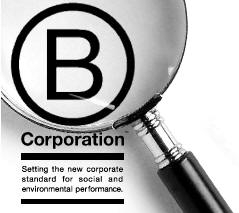
What are for-profit organizations to do, if they want to pursue social purposes and be authentic?
Until recently, organizations facing this authenticity dilemma had three options. They could:
- Attempt to manage the incongruence between their actions and their identity, and forgo authenticity,
- Resolve the inconsistency by giving up for-purpose actions and become an authentic for-profit business, or
- Resolve the inconsistency by switching the organization’s identity from for-profit to for-purpose .
All of these options are inadequate, because none of them actually addresses the real cause of these organizations’ perceived inauthenticity.
What causes this inauthenticity?
Many would lay the blame for this inauthenticity on the organization itself, arguing that the inauthenticity is caused by the organization having two goals that fundamentally contradict each other. But the issue is really not that for-profit goals and for-purpose goals contradict each other . The issue is that having both of these goals is inauthentic with having only one of these goals as the organization’s identity, as its reason for being. This problem is caused by a social, financial and legal world that limits organizations to being either for-profit or for-purpose. Up until this point, an organization’s legal identity could be either/or, but not both.
Enter the B Corporation

In the past year, a new legal form of organization has been developed that makes authenticity easier for organizations who seek simultaneously to make money and make a difference. This new organizational form is the B Corporation (where B stands for beneficial).
What’s unique about the B Corporation is that being for-profit and being for-purpose are both defined into the B Corporation’s identity through their articles of incorporation. By legally defining itself as both for-profit and for-purpose, a B Corporation can pursue both for-profit activities and for-purpose activities and think of itself as a for-purpose organization and a for-profit business, without experiencing a conflict between identity and actions.
Designing purpose and profit into the B Corporation’s identity
 The B Corporation is a clever innovation on the legal identity of the traditional C Corporation . The legal form of the B Corporation asks an organization “to incorporate stakeholder interests into (their) corporate DNA” by adding legal language that expands the responsibilities of the corporation beyond financial interests and takes into consideration the interests of all stakeholders, not just shareholders.
The B Corporation is a clever innovation on the legal identity of the traditional C Corporation . The legal form of the B Corporation asks an organization “to incorporate stakeholder interests into (their) corporate DNA” by adding legal language that expands the responsibilities of the corporation beyond financial interests and takes into consideration the interests of all stakeholders, not just shareholders.
“Stakeholders” and “Interests” embrace social purpose
- Stakeholders of B Corporations include not only owners but also employees, former employees, the community, the nation, the economy and the environment.
- Interests of B Corporations include both short term and long term outcomes, and they encompass actual results as well as opportunities (created or foreclosed) by the B Corporation’s actions.
By expanding the definitions of “stakeholders” and “interests”, the incorporation documents of a B Corporation give it great leeway in defining a social purpose . The social purpose can be a direct result of the product or service provided by the B Corporation (e.g., educational toys), it can result from the B Corporation’s methods of production or service delivery, and/or it can result from who is served and/or who is employed by the B Corporation. I can’t think of a social purpose (either good or bad) that wouldn’t be included in this expanded set of definitions. [Let me know if you can think of a social purpose that would fall outside a B Corporation’s purview.]
Because the B Corporation expands the definition of stakeholders and interests, the legal description of the organization allows it to define itself as both for-purpose and for-profit. Thus, the actions directed towards making a profit and the actions directed towards a social purpose can be understood to reflect-and be supported by-the B Corporation’s identity. No more mental gymnastics are needed to justify corporate social contributions. And, there is much less of a reason for stakeholders and outside audiences to be cynical about whether the corporation’s social purpose is genuine, or, for that matter, whether the organization is a ‘real’ business.
Both social efforts and profit generating efforts of the organization’s actions are an expression of its B Corporation identity.

B Corporation Design creates legitimacy, balance and resilience
Hardwiring both for-profit and for-purpose identity through the B Corporation’s founding document gives legitimacy to the simultaneous pursuit of goals that are usually defined as being contradictory. Instead of these goals competing with each other, and instead of one goal being sacrificed for the other, the for-purpose and for-profit goals must both be pursued.
The B Corporation’s leadership must use their judgment to balance any competing demands or potential contradictions. Designing for-profit and for-purpose into organizational identity doesn’t make this balance come easily, as studies of hybrid identity organizations have shown. However, the for-purpose/for-profit identity does make the balancing act legitimate.
Although an organization’s identity can evolve, so that an organization defines itself differently over the course of its lifetime, the decisions and organization and its founders make at the start of the organization have tremendous resilience . Because the pursuit of social purpose is designed in to the organization, it is less vulnerable to the whims and preferences of the individuals running the corporation at any given time. And, the social purpose cannot be tossed overboard in a sinking market.
The B Corporation solution looks to me like an elegant, straight-forward response to a long-standing authenticity dilemma. It offers an organizational form that corresponds directly with the dual goals and actions of the for-profit organization that also pursues social benefits, making it possible for the for-profit / for-purpose organization to be authentic.
Of course, putting social purpose into the legal definition of the organization is not enough to make for-profit / for-purpose organizations authentic. These organizations must still find a congruent way to present themselves . And they must still assess and adjust themselves to sustain a consistency between their for-profit/for-purpose identity, their image and their actions.
I’m happy to see that the founders of the B Corporation and the organizations who have already established themselves as B Corporations are alert to the challenges of staying ‘true’ to the B Corporation identity. I look forward to learning and sharing more about their efforts to express and support this new form of identity.

 I am an organizational consultant, change advocate, and organizational identity/reputation scholar with a PhD in leadership & organizations. I research, write about, and consult with organizations on the relationships between organizational identity, actions, and purpose. I teach Technology Management, part-time, at Stevens Institute of Technology.
My current research focuses on how social technologies in the workplace can drive organizational change, generate meaning, and catalyze purpose. See the
I am an organizational consultant, change advocate, and organizational identity/reputation scholar with a PhD in leadership & organizations. I research, write about, and consult with organizations on the relationships between organizational identity, actions, and purpose. I teach Technology Management, part-time, at Stevens Institute of Technology.
My current research focuses on how social technologies in the workplace can drive organizational change, generate meaning, and catalyze purpose. See the 
Comments on this entry are closed.